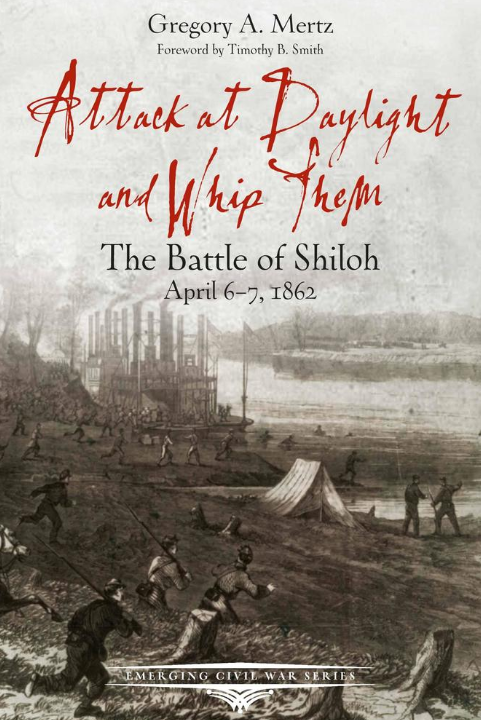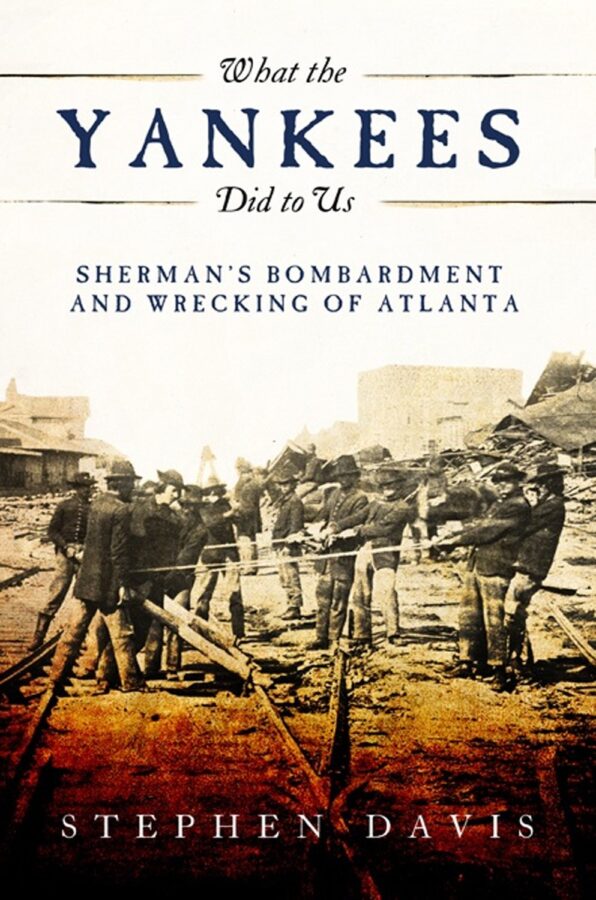Attack at Daylight and Whip Them: The Battle of Shiloh, April 6-7, 1862 by Gregory A. Mertz. Savas Beatie, 2019. Paper, ISBN: 978-1611213133. $14.95.
 This reviewer would have been surprised and at least mildly disappointed had NPS Supervisory Historian Mertz not referenced the late Tony Horwitz’s early morning encounters at Shiloh, so evocatively related in Confederates in the Attic. The people Horwitz met were not central casting tourists looking for a cheap way to keep their kids quiet, but solitary pilgrims drawn inexorably to a place for reasons that sometimes defied—and continue to defy—perfect articulation. Combining microhistory with a bit of historiography as well as it does, Attack at Daylight and Whip Them (Grant’s intention as noted to Chief Engineer James B. McPherson after the first day of battle) is the ideal battlefield guide for those souls, although the casual passerby will benefit from Mertz’s insights as well.
This reviewer would have been surprised and at least mildly disappointed had NPS Supervisory Historian Mertz not referenced the late Tony Horwitz’s early morning encounters at Shiloh, so evocatively related in Confederates in the Attic. The people Horwitz met were not central casting tourists looking for a cheap way to keep their kids quiet, but solitary pilgrims drawn inexorably to a place for reasons that sometimes defied—and continue to defy—perfect articulation. Combining microhistory with a bit of historiography as well as it does, Attack at Daylight and Whip Them (Grant’s intention as noted to Chief Engineer James B. McPherson after the first day of battle) is the ideal battlefield guide for those souls, although the casual passerby will benefit from Mertz’s insights as well.
Most important, we hear enough from the participants, both officer and enlisted, so that the “human factor” becomes apparent; this is no mere play-by-play. The author’s measured treatment of General Albert Sidney Johnston, derived from his earlier contribution to Chris Mackowksi and Kristopher D. White’s Turning Points of the American Civil War, will put the Lost Cause school in proper perspective for park visitors who might otherwise take inscriptions on monuments at face value. While effective Civil War generalship required leading from the front and getting the best from predominantly amateur armies, Johnston would not have tipped the strategic balance had he survived the war’s first mega bloodbath. The flip side, exemplified by fellow West Pointer William T. Sherman’s dismissal of accurate spot reports from newly commissioned volunteers, gets equal play.
Mertz presents his account in order of the park’s 32-stop driving tour, but he provides the essential chronological framework at the start of each chapter. Less conventional is his ability to define military terms and correct historical distortions in the text and captions without resorting to lengthy sidebars or otherwise disturbing the narrative flow: a welcome feature when treating a battle so fraught with mythology. The sunken road that was only rutted, the tree under which Sidney Johnston did not die, and the bloody pond that may not have been all that bloody are all there, along with compelling indications in keeping with more recent scholarship that Union resistance to eight Confederate assaults on the Hornet’s Nest did not by itself determine the battle’s result.
As for the dramatis personae, Benjamin Prentiss and other Hornet’s Nest survivors (including Shiloh’s first park historian, a veteran of the 12th Iowa) remain heroes, albeit heroes too close to their topic for intellectual detachment. That W.H.L. Wallace and Everett Peabody did not live long enough to write detailed after-action reports of their own could only have muddied the waters further—a factor far less obvious to casual tourists than historians. As for things going wrong in combat, Mertz leaves the impression that Wallace’s faith in Prentiss may have been as much to blame for his own death as the enemy. He also presents a compelling case for Johnston’s mortal wound possibly resulting from friendly fire.
Countering misconceptions is so central to Mertz’s mission that he devotes an entire appendix to Lew Wallace’s late arrival on April 6. It was written orders and not Wallace that got lost. Thus, Wallace marched his division to support Sherman’s right flank as per the orders he remembered, whereas Grant’s staff later claimed to have specified a different and more direct route. Only after at least two hours of marching did one of Grant’s staff officers catch Wallace and explain that Sherman’s division had fallen back. That Wallace had taken the Shunpike instead of the River Road was therefore no product of confusion, but one of intent. This scenario also illustrates perfectly the sort of blind man’s bluff played by commanders in the days before “real time” communication and aerial reconnaissance. Wallace’s actual mistakes—delaying for lunch and backtracking via a clumsy counter-column movement, instead of simply reversing his order of march—are duly noted.
So too has Grant’s post battle “spin” exerted a long-term effect on conventional wisdom. Having blamed Wallace for wasting five hours, Grant nevertheless hailed his evening arrival, rather than the Army of the Ohio’s, as the battle’s turning point. Convincing would-be critics that his own Army of the Tennessee had not needed help holding Pittsburg Landing while laying the most visible miscue at the feet of a subordinate was in Grant’s best interest—especially in the wake of such a colossal and well-publicized bloodletting.
The book contains ample illustrations, sufficient maps, and orders of battle for both sides, but no index or glossary of military terms. The glossary would have been particularly useful to park visitors unfamiliar with the text upon their arrival. These two quibbles notwithstanding, Mertz and the Emerging Civil War Series have given us excellent history in guidebook format.
John Daley is Professor of History at Pittsburg State University in Kansas.
